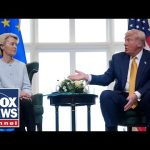Recent discussions surrounding the alleged Russia collusion have sparked renewed calls for investigations and revelations that may reshape the narrative. The topic ignited fiery debates as prominent figures like Senator Lindsey Graham and Congressman Rick Crawford took to various platforms, demanding more scrutiny into what they describe as a grand conspiracy. These developments come against a backdrop of declassified reports that many believe could expose a web of misrepresentation woven during the 2016 election.
Senator Graham’s remarks on “Meet the Press” over the weekend highlighted an urgent call for an investigation—not to prosecute former President Obama for treason, but to scrutinize the alleged fabrications connected to the Russia collusion narrative. The senator indicated that new evidence is surfacing, which contradicts narratives propagated by those in high-ranking positions in the intelligence community. Many are now questioning if there was indeed a “Russian conspiracy” aimed at undermining Donald Trump’s presidency and campaign, rather than the supposed collusion which became the focal point of an extensive investigation.
Compelling evidence has emerged that suggests figures such as former CIA Director John Brennan may have played a pivotal role in pushing a narrative that misled the public and Congress alike. Documents indicate that Brennan allegedly overruled his own team to include questionable information in intelligence assessments just weeks before the election, which further muddied the waters for Trump supporters. This brings everyone back to the idea that perhaps the so-called Russia collusion was less of a conspiracy against the nation and more about political maneuvering aimed at discrediting Trump.
The calls to declassify additional documents, as pushed by Senator Tom Cotton, amplify demands for transparency surrounding these events. Cotton believes that the annex of the Durham report needs to be made public to understand how key players like Brennan, James Comey, and others interacted with Congress regarding these matters. He argues that such revelations are crucial for the American public to grasp the entirety of the situation. In a climate where information is tightly guarded, the idea of releasing more data is being hailed as a potential watershed moment.
As the narrative unravels, Congressman Crawford argues that the statute of limitations will not protect those involved from potential consequences for their roles in this saga. He suggests that since the “conspiracy” is still purportedly ongoing, key players could still face scrutiny despite the time that has elapsed. The audacious claim that this conspiracy has been “ongoing” may allow for legal action to penetrate through statutory barriers, proving once again that conspiracies may be the courtroom’s best friend.
As these discussions unfold, one thing remains clear: the past actions during the tumultuous 2016 election cycle are coming under a magnifying glass. Many GOP leaders are rallying for what they believe is the need for accountability; they want the public to see the true nature of the events that unfolded. As the potential for more information to emerge becomes tangible, the question remains—how will this impact America’s view on the events of the past and those who orchestrated them? The landscape of American politics is undoubtedly shifting, and audiences would be wise to keep their eyes peeled for what could be the latest chapter in this ever-evolving tale.




